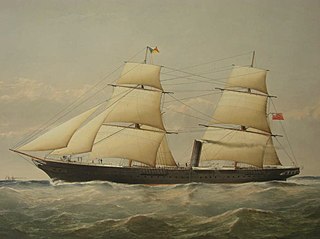
SS Carnatic was a British steamship built in 1862-63 by Samuda Brothers at Cubitt Town on the Isle of Dogs, London, for the Peninsular and Oriental Steam Navigation Company (P&O). She operated on the Suez to Bombay run in the last years before the Suez Canal was opened. This route gave a fast, steamship-operated route from Britain to India, connecting with similar steamships running through the Mediterranean to Alexandria, with an overland crossing to Suez. The alternative was to sail round the Cape of Good Hope, a distance at which steam ships were not, in the early 1860s, sufficiently economical to be commercially competitive with sail.

A shipwreck is the remains of a ship that has wrecked, which are found either beached on land or sunken to the bottom of a body of water. Shipwrecking may be deliberate or accidental. In January 1999, Angela Croome estimated that there have been about three million shipwrecks worldwide.

Marine salvage is the process of recovering a ship and its cargo after a shipwreck or other maritime casualty. Salvage may encompass towing, re-floating a vessel, or effecting repairs to a ship. Today, protecting the coastal environment from spillage of oil or other contaminants is a high priority. Before the invention of radio, salvage services would be given to a stricken vessel by any ship that happened to be passing by. Nowadays, most salvage is carried out by specialist salvage firms with dedicated crew and equipment.

Alkimos was a Greek-owned merchant ship which was wrecked on the coast north of Perth, Western Australia in 1963. A nearby locality was later named after the vessel. The wreck is a popular diving venue.
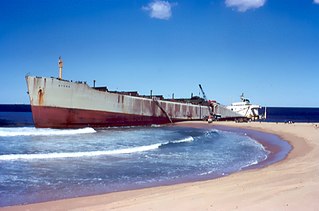
MV Sygna was a Norwegian bulk carrier built by Austin & Pickersgill for J. Ludwig Mowinckels Rederi in 1967. It ran aground on Stockton Beach in Australia during a major storm in 1974. After its bow section was refloated, its stern remained beached and became an icon and landmark for the local area, until the visible remains of the wreck collapsed into the sea in 2016.
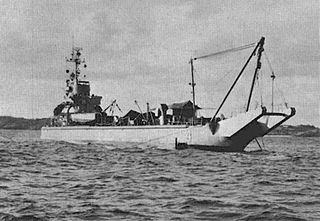
USS Windlass, a Gypsy-class salvage lifting vessel of the United States Navy, was originally conceived as LSM-552 and laid down on 27 August 1945 at Houston, Texas, by Brown Shipbuilding Corporation. Launched on 7 December 1945; and commissioned on 9 April 1946 in Houston at the Tennessee Coal and Iron Docks, Lieutenant Commander Rodney F. Snipes, USNR, in command.

HMT Gulland was one of a number of Isles-class trawlers built for the Royal Navy during the Second World War for a variety of tasks, including anti-submarine patrol. She was launched placed on the disposal list after the war and sold to Belgian owners in March 1946. The following year the ship changed hands and was renamed Henken and two years later sold to Arab Navigation & Transport Co. in Aden and renamed Arab Trader.

HMS Montagu was a Duncan-class pre-dreadnought battleship of the British Royal Navy. Built to counter a group of fast Russian battleships, Montagu and her sister ships were capable of steaming at 19 knots, making them the fastest battleships in the world. The Duncan-class battleships were armed with a main battery of four 12-inch (305 mm) guns and they were broadly similar to the London-class battleships, though of a slightly reduced displacement and thinner armour layout. As such, they reflected a development of the lighter second-class ships of the Canopus-class battleship. Montagu was built between her keel laying in November 1899 and her completion in July 1903. The ship had a brief career, serving for two years in the Mediterranean Fleet before transferring to the Channel Fleet in early 1905. During wireless telegraphy experiments in May 1906, she ran aground off Lundy Island. Repeated attempts to refloat the ship failed, and she proved to be a total loss. She was ultimately broken up in situ.
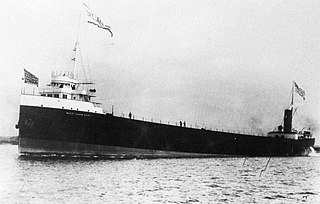
The Chester A. Congdon was a bulk steel freighter named after the lawyer and capitalist of the same name. It was launched in 1907 and sank on November 6, 1918 in Lake Superior near Isle Royale. The wreckage remains at the bottom of the lake, and in 1984 was placed on the National Register of Historic Places.
Saltfleet was a 1,051 GRT coaster which was built in 1944 by John Lewis & Sons Ltd, Aberdeen as Empire Cheyne. She was built for the Ministry of War Transport (MoWT). In 1946 she was sold and renamed Saltfleet. In October 1951, she ran aground at Reedness. Although salvage operations commenced in December 1951, they were abandoned in October 1952. Upon resumption of salvage in 1953, it was found that Saltfleet had broken her back, and the ship was scrapped in two parts, that of the bow section in May 1954 while the stern section was not scrapped until October 1954.

The RMS Mülheim was a German cargo ship that was built in Romania and launched in May 1999. It was wrecked on 22 March 2003 at Land's End, United Kingdom.
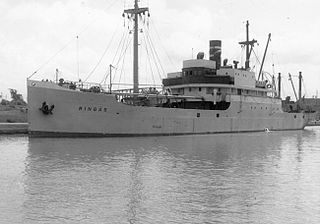
Francisco Morazan was a 1,442 GRT cargo ship that was built in 1922 as Arcadia by Deutsche Werft, Hamburg, for German owners. She was sold in 1924 and renamed Elbing. She was seized by the Allies in the River Elbe, Germany in May 1945, passed to the United Kingdom's Ministry of War Transport and renamed Empire Congress. In 1946, she was allocated to the Norwegian Government and renamed Brunes.
The Liverpool & Glasgow Salvage Association was formed on 1 January 1924 from the merger of the Liverpool Salvage Association and the Glasgow Salvage Association.
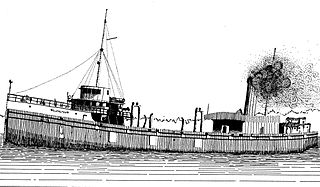
The Glenlyon was a freighter built in 1893; it was sunk off the shore of Isle Royale in Lake Superior in 1924 and the remains are still on the lake bottom. The wreck was placed on the National Register of Historic Places in 1984.

America was a packet boat transporting passengers, mail, and packages between settlements along the North Shore of Lake Superior, an inland sea in central North America. Built in 1898, America sank in Washington Harbor off the shore of Isle Royale in 1928, where the hull still remains. The wreck was placed on the National Register of Historic Places in 1984.

The Cumberland was a wooden-hulled side paddlewheeler built in 1871; it was wrecked off the shore of Isle Royale in Lake Superior in 1877 and the remains are still on the lake bottom. The wreck was placed on the National Register of Historic Places in 1984.
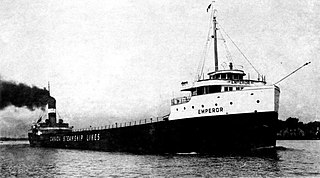
The Emperor was a freighter built in 1910; it sank off the shore of Isle Royale in Lake Superior in 1947 and the remains are still on the lake bottom. The wreck was placed on the National Register of Historic Places in 1984.

Astrolabe Reef is near Motiti Island, 20 kilometres NE of Tauranga, off the Bay of Plenty coast in New Zealand. The reef, which breaks the water surface at low tide, is a renowned scuba diving spot that drops off to 37 metres (121 ft) in different parts. The reef was named by Jules Dumont d'Urville after his ship Astrolabe, when it nearly ran aground there on 16 February 1827.

MV Canadian Miner was a Canadian laker that was part of the fleet of Upper Lakes Shipping from 1994–2011. Initially constructed as Maplecliffe Hall in 1966, the ship was renamed Lemoyne in 1988 before becoming Canadian Miner in 1994. In 2011, the name was shortened to just Miner. In 2011 the vessel was taken out of service and sold for scrapping. While en route to the scrapyard in Turkey, the ship ran aground off Nova Scotia in 2011. The vessel was broken up in 2014 in Nova Scotia.
The Dania was a cargo ship that got scuttled aground on 27 October 2002 along Nyali Reef, just off Bamburi, Kenya.
















